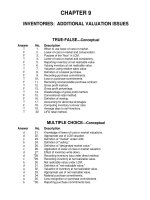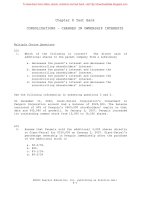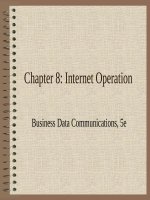business english 2e by mary chapter 08
Bạn đang xem bản rút gọn của tài liệu. Xem và tải ngay bản đầy đủ của tài liệu tại đây (935.43 KB, 34 trang )
8
Prepositions
MARY ELLEN GUFFEY AND CAROLYN M. SEEFER
BUSINESS
ENGLISH
12e
© 2017 Cengage Learning®. May not be scanned, copied or duplicated, or posted to a publicly accessible website, in whole or in part, except for use as
permitted in a license distributed with a certain product or service or otherwise on a password-protected website or school-approved learning management
system for classroom use.
© Larysa Ray/Shutterstock. © Valeri Potapova/Shutterstock.
L E A R N I N G
O U T C O M E S
Level 1
▶. Use objective-case pronouns as objects of
prepositions.
▶. Avoid using prepositions in place of verbs and
adverbs.
© 2017 Cengage Learning®. May not be scanned, copied or duplicated, or posted to a publicly accessible website, in whole or in part, except for use as permitted in a license distributed with a certain product or service or otherwise on a password-protected website or school-approved learning management system for classroom use.
© Larysa Ray/Shutterstock
2
Commonly Used Prepositions
about
beside
in/into
above
but
like
according to
by
near
after
due to
of
along with
during
on
at
except
to
before
for
under
between
from
with
© 2017 Cengage Learning®. May not be scanned, copied or duplicated, or posted to a publicly accessible website, in whole or in part, except for use as permitted in a license distributed with a certain product or service or otherwise on a password-protected website or school-approved learning
© 2017 Cengage Learning®. May not be scanned, copied or duplicated, or posted to a publicly accessible website, in whole or in part, except for use as permitted in a license distributed with a certain product or service or otherwise on a password-protected website or school-approved learning management system for classroom use.
management system for classroom use. © Larysa Ray/Shutterstock
© Larysa Ray/Shutterstock
3
Prepositional Phrases
A preposition often appears in a prepositional phrase:
Preposition + Object = Prepositional Phrase
The object of a preposition is a noun or pronoun.
She placed her briefcase under her desk.
We really need to hire an intern like him.
© 2017 Cengage Learning®. May not be scanned, copied or duplicated, or posted to a publicly accessible website, in whole or in part, except for use as permitted in a license distributed with a certain product or service or otherwise on a password-protected website or school-approved learning
© 2017 Cengage Learning®. May not be scanned, copied or duplicated, or posted to a publicly accessible website, in whole or in part, except for use as permitted in a license distributed with a certain product or service or otherwise on a password-protected website or school-approved learning management system for classroom use.
management system for classroom use. © Larysa Ray/Shutterstock
© Larysa Ray/Shutterstock
4
Objective Case Following Prepositions
Use objective-case pronouns (me, us, you, him, her, it, and
them) as objects of prepositions.
Everyone except Leslie and her arrived early.
Just between you and me,
sales are increasing.
© 2017 Cengage Learning®. May not be scanned, copied or duplicated, or posted to a publicly accessible website, in whole or in part, except for use as permitted in a license distributed with a certain product or service or otherwise on a password-protected website or school-approved learning
© 2017 Cengage Learning®. May not be scanned, copied or duplicated, or posted to a publicly accessible website, in whole or in part, except for use as permitted in a license distributed with a certain product or service or otherwise on a password-protected website or school-approved learning management system for classroom use.
management system for classroom use. © Larysa Ray/Shutterstock
© Larysa Ray/Shutterstock
5
Typical Problems With Prepositions
Using of for have
Using of for from
Using to for too
© 2017 Cengage Learning®. May not be scanned, copied or duplicated, or posted to a publicly accessible website, in whole or in part, except for use as permitted in a license distributed with a certain product or service or otherwise on a password-protected website or school-approved learning
© 2017 Cengage Learning®. May not be scanned, copied or duplicated, or posted to a publicly accessible website, in whole or in part, except for use as permitted in a license distributed with a certain product or service or otherwise on a password-protected website or school-approved learning management system for classroom use.
management system for classroom use. © Larysa Ray/Shutterstock
© Larysa Ray/Shutterstock
6
Using of for have
Do not substitute the preposition of for the verb have.
They should have (not of ) walked to the restaurant.
We could have (not of )
received free tickets.
We would have (not of ) attended the concert if we had known
about it.
© 2017 Cengage Learning®. May not be scanned, copied or duplicated, or posted to a publicly accessible website, in whole or in part, except for use as permitted in a license distributed with a certain product or service or otherwise on a password-protected website or school-approved learning
© 2017 Cengage Learning®. May not be scanned, copied or duplicated, or posted to a publicly accessible website, in whole or in part, except for use as permitted in a license distributed with a certain product or service or otherwise on a password-protected website or school-approved learning management system for classroom use.
management system for classroom use. © Larysa Ray/Shutterstock
© Larysa Ray/Shutterstock
7
Using of for from
Do not replace the preposition from with the words of or of
of.
Can I get the user data from (not of or of of ) you?
Christine borrowed the pen from (not of or of of ) Brandon.
© 2017 Cengage Learning®. May not be scanned, copied or duplicated, or posted to a publicly accessible website, in whole or in part, except for use as permitted in a license distributed with a certain product or service or otherwise on a password-protected website or school-approved learning
© 2017 Cengage Learning®. May not be scanned, copied or duplicated, or posted to a publicly accessible website, in whole or in part, except for use as permitted in a license distributed with a certain product or service or otherwise on a password-protected website or school-approved learning management system for classroom use.
management system for classroom use. © Larysa Ray/Shutterstock
© Larysa Ray/Shutterstock
8
Using to for too
Do not use the preposition to ( “in a direction toward”) in place of
the adverb too (“additionally,” “also,” or “excessively”).
Give the cash receipts to the courier.
Sales reps received tablets and smartphones too.
The car was too small to
carry the equipment.
© 2017 Cengage Learning®. May not be scanned, copied or duplicated, or posted to a publicly accessible website, in whole or in part, except for use as permitted in a license distributed with a certain product or service or otherwise on a password-protected website or school-approved learning
© 2017 Cengage Learning®. May not be scanned, copied or duplicated, or posted to a publicly accessible website, in whole or in part, except for use as permitted in a license distributed with a certain product or service or otherwise on a password-protected website or school-approved learning management system for classroom use.
management system for classroom use. © Larysa Ray/Shutterstock
© Larysa Ray/Shutterstock
9
TRY
TRY YOUR
YOUR SKILL
SKILL
Choose the correct word
1.
idea.
to complete these
sentences.
Between you and (I/me), I didn’t like his
2.
We should (have/of) arrived earlier.
3.
Suzanne borrowed some money (of
of/from) her daughter.
4.
The rent for this office space is (to/too)
high.
© 2017 Cengage Learning®. May not be scanned, copied or duplicated, or posted to a publicly accessible website, in whole or in part, except for use as permitted in a license distributed with a certain product or service or otherwise on a password-protected website or school-approved learning
© 2017 Cengage Learning®. May not be scanned, copied or duplicated, or posted to a publicly accessible website, in whole or in part, except for use as permitted in a license distributed with a certain product or service or otherwise on a password-protected website or school-approved learning management system for classroom use.
management system for classroom use. © Larysa Ray/Shutterstock
© Larysa Ray/Shutterstock
10
L E A R N I N G
O U T C O M E S
Level 2
▶. Use challenging prepositions correctly.
▶. Retain necessary prepositions, omit unnecessary
ones, and construct formal sentences that avoid
terminal prepositions.
© 2017 Cengage Learning®. May not be scanned, copied or duplicated, or posted to a publicly accessible website, in whole or in part, except for use as permitted in a license distributed with a certain product or service or otherwise on a password-protected website or school-approved learning management system for classroom use.
© Larysa Ray/Shutterstock
11
Challenges With Prepositions
Commonly Confused Prepositions
Necessary Prepositions
Unnecessary Prepositions
Ending a Sentence With a Preposition
© 2017 Cengage Learning®. May not be scanned, copied or duplicated, or posted to a publicly accessible website, in whole or in part, except for use as permitted in a license distributed with a certain product or service or otherwise on a password-protected website or school-approved learning
© 2017 Cengage Learning®. May not be scanned, copied or duplicated, or posted to a publicly accessible website, in whole or in part, except for use as permitted in a license distributed with a certain product or service or otherwise on a password-protected website or school-approved learning management system for classroom use.
management system for classroom use. © Larysa Ray/Shutterstock
© Larysa Ray/Shutterstock
12
Commonly Confused Prepositions
Among,
Beside,
Between
Besides
In, Into,
Except
In to
Like
© 2017 Cengage Learning®. May not be scanned, copied or duplicated, or posted to a publicly accessible website, in whole or in part, except for use as permitted in a license distributed with a certain product or service or otherwise on a password-protected website or school-approved learning
© 2017 Cengage Learning®. May not be scanned, copied or duplicated, or posted to a publicly accessible website, in whole or in part, except for use as permitted in a license distributed with a certain product or service or otherwise on a password-protected website or school-approved learning management system for classroom use.
management system for classroom use. © Larysa Ray/Shutterstock
© Larysa Ray/Shutterstock
Among: used to speak of three or
Among,
Between
more persons or things
Between: used to speak of two
persons or things
Profits will be divided among the nine partners.
Responsibility will be divided between the vice president and the
general manager.
© 2017 Cengage Learning®. May not be scanned, copied or duplicated, or posted to a publicly accessible website, in whole or in part, except for use as permitted in a license distributed with a certain product or service or otherwise on a password-protected website or school-approved learning
© 2017 Cengage Learning®. May not be scanned, copied or duplicated, or posted to a publicly accessible website, in whole or in part, except for use as permitted in a license distributed with a certain product or service or otherwise on a password-protected website or school-approved learning management system for classroom use.
management system for classroom use. © Larysa Ray/Shutterstock
© Larysa Ray/Shutterstock
Beside: means “next to”
Beside,
Besides: means “in addition to”
Besides
You have another option besides this one.
The carpool parking lot is beside the office.
© 2017 Cengage Learning®. May not be scanned, copied or duplicated, or posted to a publicly accessible website, in whole or in part, except for use as permitted in a license distributed with a certain product or service or otherwise on a password-protected website or school-approved learning
© 2017 Cengage Learning®. May not be scanned, copied or duplicated, or posted to a publicly accessible website, in whole or in part, except for use as permitted in a license distributed with a certain product or service or otherwise on a password-protected website or school-approved learning management system for classroom use.
management system for classroom use. © Larysa Ray/Shutterstock
© Larysa Ray/Shutterstock
Except (preposition): means “but” or
Except
excluding”
Accept (verb): means “to receive”
All pages except three must be edited.
We will accept applications for the position online.
© 2017 Cengage Learning®. May not be scanned, copied or duplicated, or posted to a publicly accessible website, in whole or in part, except for use as permitted in a license distributed with a certain product or service or otherwise on a password-protected website or school-approved learning
© 2017 Cengage Learning®. May not be scanned, copied or duplicated, or posted to a publicly accessible website, in whole or in part, except for use as permitted in a license distributed with a certain product or service or otherwise on a password-protected website or school-approved learning management system for classroom use.
management system for classroom use. © Larysa Ray/Shutterstock
© Larysa Ray/Shutterstock
In, Into,
In: indicates a position or location
In to
He is interested in underwater photography.
The event took place in the
new World Trade Center
in New York City.
© 2017 Cengage Learning®. May not be scanned, copied or duplicated, or posted to a publicly accessible website, in whole or in part, except for use as permitted in a license distributed with a certain product or service or otherwise on a password-protected website or school-approved learning
© 2017 Cengage Learning®. May not be scanned, copied or duplicated, or posted to a publicly accessible website, in whole or in part, except for use as permitted in a license distributed with a certain product or service or otherwise on a password-protected website or school-approved learning management system for classroom use.
management system for classroom use. © Larysa Ray/Shutterstock
© Larysa Ray/Shutterstock
Into (one word): means three
In, Into,
In to
things:
Entering something
Changing form
Making contact
Entering into something
She plans to go into accounting.
We will move into our new building soon.
Changing form
He is turning into a talented musician.
The caterpillar changed into a butterfly.
Making contact
I just ran into an old high school friend.
The player ran into the outfield wall.
© 2017 Cengage Learning®. May not be scanned, copied or duplicated, or posted to a publicly accessible website, in whole or in part, except for use as permitted in a license distributed with a certain product or service or otherwise on a password-protected website or school-approved learning
© 2017 Cengage Learning®. May not be scanned, copied or duplicated, or posted to a publicly accessible website, in whole or in part, except for use as permitted in a license distributed with a certain product or service or otherwise on a password-protected website or school-approved learning management system for classroom use.
management system for classroom use. © Larysa Ray/Shutterstock
© Larysa Ray/Shutterstock
In to (two words): the adverb in
In, Into,
In to
preceding an infinitive or a
prepositional phrase
She went in to see the doctor to get her lab results. (to see is
an infinitive)
Please turn the report in to your boss on time. (to your boss
is a prepositional phrase)
© 2017 Cengage Learning®. May not be scanned, copied or duplicated, or posted to a publicly accessible website, in whole or in part, except for use as permitted in a license distributed with a certain product or service or otherwise on a password-protected website or school-approved learning
© 2017 Cengage Learning®. May not be scanned, copied or duplicated, or posted to a publicly accessible website, in whole or in part, except for use as permitted in a license distributed with a certain product or service or otherwise on a password-protected website or school-approved learning management system for classroom use.
management system for classroom use. © Larysa Ray/Shutterstock
© Larysa Ray/Shutterstock
The preposition like should be used to
introduce nouns or pronouns. Do not
Like
use like to introduce clauses.
My friend looks a lot like Natalie Portman.
I wish I could sing like him.
I feel as if (not like) I don’t have enough time to complete the
project.
He looks as though (not like) he didn’t get enough sleep last
night.
© 2017 Cengage Learning®. May not be scanned, copied or duplicated, or posted to a publicly accessible website, in whole or in part, except for use as permitted in a license distributed with a certain product or service or otherwise on a password-protected website or school-approved learning
© 2017 Cengage Learning®. May not be scanned, copied or duplicated, or posted to a publicly accessible website, in whole or in part, except for use as permitted in a license distributed with a certain product or service or otherwise on a password-protected website or school-approved learning management system for classroom use.
management system for classroom use. © Larysa Ray/Shutterstock
© Larysa Ray/Shutterstock
Necessary Prepositions
Be sure to include those prepositions necessary to clarify a
relationship.
Be particularly careful when two prepositions modify a single
object.
Our appreciation for and interest in the project remain great. (Do
not omit for.)
What style of interview suit do you prefer? (Do not omit of.)
She graduated from high
school last year. (Do not omit
from.)
© 2017 Cengage Learning®. May not be scanned, copied or duplicated, or posted to a publicly accessible website, in whole or in part, except for use as permitted in a license distributed with a certain product or service or otherwise on a password-protected website or school-approved learning
© 2017 Cengage Learning®. May not be scanned, copied or duplicated, or posted to a publicly accessible website, in whole or in part, except for use as permitted in a license distributed with a certain product or service or otherwise on a password-protected website or school-approved learning management system for classroom use.
management system for classroom use. © Larysa Ray/Shutterstock
© Larysa Ray/Shutterstock
21
Unnecessary Prepositions
Omit unnecessary prepositions.
I’m not sure when the meeting is scheduled for. (not
“scheduled for”)
The delivery was left outside of
the door. (not “outside of”)
Where would you like to meet at?
(not “meet at”)
Did that earthquake this morning wake you up? (not “wake
you up”)
© 2017 Cengage Learning®. May not be scanned, copied or duplicated, or posted to a publicly accessible website, in whole or in part, except for use as permitted in a license distributed with a certain product or service or otherwise on a password-protected website or school-approved learning
© 2017 Cengage Learning®. May not be scanned, copied or duplicated, or posted to a publicly accessible website, in whole or in part, except for use as permitted in a license distributed with a certain product or service or otherwise on a password-protected website or school-approved learning management system for classroom use.
management system for classroom use. © Larysa Ray/Shutterstock
© Larysa Ray/Shutterstock
22
Ending a Sentence With a Preposition
In formal writing, careful writers avoid ending sentences with
prepositions.
Less Formal
More Formal
What topic did he lecture on?
On what topic did he lecture?
Whom do you wish to speak to?
To whom do you wish to speak?
© 2017 Cengage Learning®. May not be scanned, copied or duplicated, or posted to a publicly accessible website, in whole or in part, except for use as permitted in a license distributed with a certain product or service or otherwise on a password-protected website or school-approved learning
© 2017 Cengage Learning®. May not be scanned, copied or duplicated, or posted to a publicly accessible website, in whole or in part, except for use as permitted in a license distributed with a certain product or service or otherwise on a password-protected website or school-approved learning management system for classroom use.
management system for classroom use. © Larysa Ray/Shutterstock
© Larysa Ray/Shutterstock
23
TRY
TRY YOUR
YOUR SKILL
SKILL
Choose the correct word
1.
(between/among) the two of us.
to complete these
sentences.
Let’s divide the pizza evenly
2.
Dividends will be divided (between/among)
all stockholders.
3.
The break room is located (beside/besides)
the copy room.
© 2017 Cengage Learning®. May not be scanned, copied or duplicated, or posted to a publicly accessible website, in whole or in part, except for use as permitted in a license distributed with a certain product or service or otherwise on a password-protected website or school-approved learning
© 2017 Cengage Learning®. May not be scanned, copied or duplicated, or posted to a publicly accessible website, in whole or in part, except for use as permitted in a license distributed with a certain product or service or otherwise on a password-protected website or school-approved learning management system for classroom use.
management system for classroom use. © Larysa Ray/Shutterstock
© Larysa Ray/Shutterstock
24
TRY
TRY YOUR
YOUR SKILL
SKILL
Choose the correct word
4.
us a list of references.
to complete these
sentences.
(Beside/Besides) your résumé, please send
5.
Everyone (except/accept) him was given a
raise.
6.
You should go (into/in to) see your boss
after lunch.
© 2017 Cengage Learning®. May not be scanned, copied or duplicated, or posted to a publicly accessible website, in whole or in part, except for use as permitted in a license distributed with a certain product or service or otherwise on a password-protected website or school-approved learning
© 2017 Cengage Learning®. May not be scanned, copied or duplicated, or posted to a publicly accessible website, in whole or in part, except for use as permitted in a license distributed with a certain product or service or otherwise on a password-protected website or school-approved learning management system for classroom use.
management system for classroom use. © Larysa Ray/Shutterstock
© Larysa Ray/Shutterstock
25









